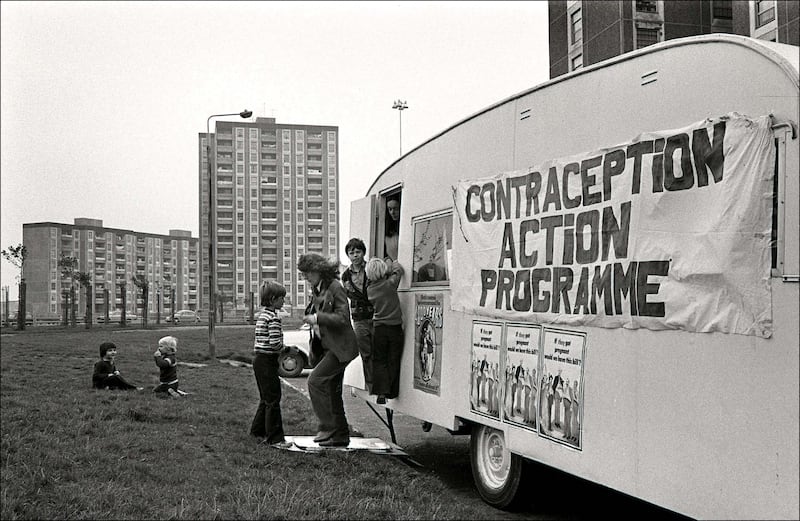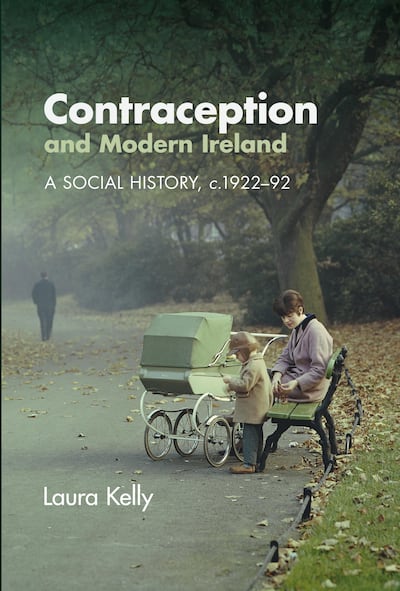By 1961, the number of births per married woman in Ireland was 19.5 per 1,000, almost double that of England and Wales. During that decade it was clear some couples were trying to limit the number of children they had, but it was still the case that by 1967, 23 per cent of women who gave birth in the National Maternity Hospital (NMH) were having their fifth child.
The confession box was an important space for some Irish women attempting to engage in dialogue about contraception in the 1960s and 1970s. It was hardly something they looked forward to. Ellie, born in 1944, used the withdrawal method with her husband to try to space out pregnancies. She informed the priest and he was having none of it; he told Ellie “that I was committing the sin that I was depriving my husband out of his pleasure”. Ellie “felt dreadful and I remember, he kept me for bloody ages”, a reminder that women could be admonished if they sought to raise their concerns about the physical, emotional and material toll of repeated pregnancies.
This important book is full of testimony about endurance of this kind as women dealt with multiple pregnancies during an era when artificial contraception was illegal as a result of the 1935 Criminal Law Amendment Act that criminalised the importation and sale of contraceptives. Built on the back of the personal experiences of 103 interviewees (73 women and 30 men) born in Ireland before 1955, the book also provides dense detail about the wider history of contraception as reflected in numerous archives. It is absorbing, disturbing and revealing, if somewhat repetitive and didactic (“Why is this book important?” is one section heading). The author gave talks to a variety of community groups in order to persuade people to volunteer to be interviewed and our recorded social history is now the better as a result of their candour.
Correspondence between (usually middle-class) Irish women and men and the British birth control campaigner Marie Stopes in the 1920s reminds us that from the earliest years of the State, the Irish contraceptive dilemma was being privately aired. A 28-year-old Limerick woman wrote to Stopes in 1923; she had been married for nine years and had six children: “I feel I have done my bit and only wish I could be in London to go to your clinic.” Some of the letters were framed around health concerns; the dilemma for some was that while they were being advised on medical grounds not to have more children, they were not being given information on how to prevent pregnancy, and the thirst for such information endured.
Crackdowns by detectives and customs officers on chemist shops in Dublin in 1936 led to fines and imprisonment, one judge insisting “the greatest danger in European civilisation today was the question of birth control”.

Advice and education, if it came at all, was hurried and embarrassed. Ann, born in 1945, was told by her mother in relation to her first period: “You’ll be getting those now every month. And that was it.” Another short lesson on sex from a mother to a daughter was “keep your legs together”. It was no wonder that by the 1960s, the pages of women’s magazines, especially Woman’s Way, as demonstrated by historian Caitríona Clear, became forums for questions and information; of 1,186 letters published on that magazine’s problem pages between 1963 and 1969, 31.5 per cent concerned sex education or information. According to Brigid, born in 1945, “we weren’t even allowed say the word pregnant” and fear, born of silences as well as lay and religious sermonising, abounded.
One 38-year-old woman with five children and high blood pressure asked her doctor for the pill in 1966 and was told ‘I would have to wait until they got word from Rome’
Ireland’s best known agony aunt, Angela MacNamara, insisted in 1963 in Woman’s Way that artificial contraception would lead to “moral degradation”, but the same magazine was publishing articles on the pill by 1968 as it became increasingly difficult to contain controversies about contraception, and voices for greater liberalisation became louder.
[ Michael McDowell: Archbishop in no position to talk about groupthinkOpens in new window ]
The interviews are also revealing on natural family planning methods: “Calendar methods such as the safe period, temperature method, and later Billings method” (observation of cervical mucus), along with the withdrawal method. These were not reliable for many, and generated much stress and anxious waiting. Sally, born in 1956, reflects on all the women “sitting at the table having breakfast, or her dinner, and these thoughts: Am I pregnant?”
Doctors had significant power given that the pill was available in Ireland on prescription from 1963 as a menstrual cycle regulator, but in reality was confined to fee-paying, middle-class women with an understanding doctor. For some doctors, their status as “sympathetic was undoubtedly lucrative”. One 38-year-old woman with five children and high blood pressure asked her doctor for the pill in 1966 and was told “I would have to wait until they got word from Rome”, a reference to the widespread expectation that the Vatican would soften its stance in relation to artificial contraception. It did not, and controversy over Pope Paul VI’s encyclical Humanae Vitae also raged in Poland, Spain and Portugal.

There was a family planning clinic at the NMH in the 1960s, but doctors were deeply divided about artificial contraception. Declan Meagher and Dermot MacDonald, who ran the clinic, believed by 1967 the issue was “not the morality of taking the pill but rather the morality of refusing to provide it for patients who feel entitled, in conscience, to take it”.
[ Many men refused to marry pregnant women ‘over fear of losing social standing’Opens in new window ]
However, the master of the NMH, Kieran O’Driscoll, wrote to the Catholic archbishop of Dublin John Charles McQuaid after Humanae Vitae, promising its tenets would be strictly adhered to. Devout Catholic mothers also expressed satisfaction with Church teaching, including the Longford woman who wrote to McQuaid in 1971: “We have 12 boys and 2 girls and I lost 5″. She said she had chronic heath problems, just one kidney, and “I nearly went to the mental with the nerves”, but she was fully in favour of McQuaid’s pastoral letters decrying any right to contraception. In contrast, a woman who was told after serious surgery not to get pregnant again asked McQuaid: “Have you any idea of the mental and spiritual anguish of a Catholic mother placed in this predicament?”
Feminist activists, mostly middle-class, became increasingly emboldened from the late 1960s through such groups such as the Irish Family Planning Association
Of course he did not and could not, just like the priests in the confession boxes who “weren’t bloomin’ well coming to feed them, were they?” remarks Jessie, who was told to keep getting pregnant against her will. One husband went to the priest because his wife refused to have intercourse, “and came home all holy and with permission”. Before 1990, wives did not have the legal right to refuse intercourse with their husbands.
Feminist activists, mostly middle-class, became increasingly emboldened from the late 1960s through such groups such as the Irish Family Planning Association (IFPA), various regional planning clinics and the Well Woman Centre, all established between 1969 and 1978. There was a growing anger and defiance, but it was still difficult to recruit doctors. The Irish Women’s Liberation Movement also took up the cause, while for Irish Women United, access to contraception became “their most sustained public campaign”. Those involved in the Contraception Action Programme (CAP) established in 1976 were keen to stress the class dimension to contraception access. The campaigns were risky and there was nervousness about arrests owing to the setting up of a shop, Contraceptives Unlimited, in Harcourt Street by CAP.

There was well-organised opposition to these developments; organisations including the League of Decency, Family League and Save Our Society railed against a change in the law or Catholic ethos. The founder of the Nazareth Family Movement, Marie Dunleavy MacSharry, was inspired by the efforts of Mary Whitehouse in England to tackle the “permissiveness in our midst”. MacSharry described herself as “the mother of 12 children, 6 surviving”. John O’Reilly, chairman of the Irish Family League, which claimed 2,000 members by 1980, expressed amazement “that there was so much approving publicity about contraception although it was illegal”. These groups produced numerous well-researched publications and were prolific writers to newspapers.
While further liberalisation in 1985 removed the need for a prescription for non-medical contraceptives, purchasing them remained a furtive and embarrassing business
Even with the 1979 Family Planning Act, designed to ensure that “contraceptives are available only for the purpose, bona fide, of family planning” and only on prescription, there was no guarantee that chemists would stock them. A government survey in 1983 estimated that “only 300 of the 1,100 chemists in the country stocked and sold non-medical contraceptives”. As Marguerite Egan of the Tralee Women’s group put it, “you would think they are explosives the way they are treated”.
[ Opinion poll shows Irish favour a more liberal, less dogmatic, Catholic ChurchOpens in new window ]
While further liberalisation in 1985 removed the need for a prescription for non-medical contraceptives, purchasing them remained a furtive and embarrassing business. The IFPA sought to provoke a prosecution by selling condoms in the Virgin Megastore in 1988 but it took 18 months before there was any legal action, after which the IFPA was fined £400. The judge in the case made it clear he had taken Holy Communion that morning, the court scene that day a reminder of the mix of law, religion and defiance that enveloped the contraception question for seven decades.
Diarmaid Ferriter is Professor of Modern Irish History at UCD. His most recent book is Between Two Hells: The Irish Civil War (Profile Books)
Further reading
Clíona Rattigan’s What Else Could I do?: Single mothers and Infanticide, Ireland 1900-1950 (Irish Academic Press, 2012) excavates criminal court records to analyse 300 infanticide cases in Ireland, north and south, underlining the devastation caused by unwanted pregnancies. Caitríona Clear’s Women’s Voices in Ireland: women’s magazines in the 1950s and 1960s (Bloomsbury, 2016) examines letters sent by Irish women to popular magazines; they are valuable sources given there were so few forums available to women to air their problems. The letters underline changing social and economic contexts for women of that era and how their experiences differed from those of their mothers. The dilemma for Catholics seeking to reconcile their religion with a desire for contraception was far from just an Irish issue; David Lodge’s novel How Far Can you Go? (Secker & Warburg, 1980) looks at the dilemmas of Catholic couples in 1950s England: “your conscience would tell you, no further than you wouldn’t be ashamed to tell your mother”












